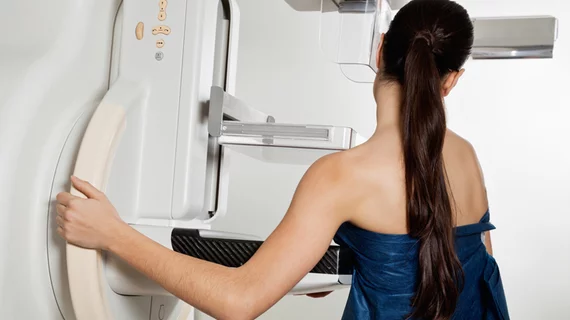Wide-angle, two-view digital breast tomosynthesis (DBT) offers greater accuracy in breast cancer diagnosis than full-field digital mammography (FFDM), according to a study running in the June edition of the American Journal of Roentgenology.
“Most clinical studies reported to date have been conducted with narrow-angle DBT systems,” wrote lead author Dianne Georgian-Smith, MD, department of radiology, Brigham and Women’s Hospital in Boston, and colleagues. “The population-based Malmö Breast Tomosynthesis Screening Trial, however, showed a fairly large increase in cancer detection rate with the use of one-view-only (mediolateral oblique) wide-angle DBT versus two-view (mediolateral oblique and craniocaudal) FFDM—8.7 per 1,000 screens for one-view DBT versus 6.5 per 1,000 screens for two-view FFDM—but with a minimal increase in recall rate from 2.6% to 3.6%.”
The researchers undertook a multi-reader, multi-case investigation to determine whether two-view DBT without 2D synthesized views or FFDM in which images are acquired with a wide-angle DBT system would prove superior to two-view FFDM in detecting breast cancer. Over two sessions separated by more than one month, 31 readers independently reviewed bilateral two-view FFDM and bilateral two-view wide-angle DBT images. A total of 330 patient cases were selected from a pool of patients undergoing screening and diagnostic mammography. Endpoints evaluated included the ROC AUC ( mean receiver operating characteristic/area under the curve) per breast (breast level) ROC AUC per patient (subject level), non-cancer recall rates, sensitivity, and specificity.
All radiologists participated in a 10-hour training session before reading the study cases; this involved a four-hour lecture, 1.5 hours at the workstation to learn how to enter the data, and 4.5 hours of case review. The training provided them with an overview of DBT physics, examples of lesion features in wide-angle DBT, interpretation approaches to DBT studies and instructions on using the image review workstation.
Of the 31 readers who participated in the study, 29 performed better with DBT than with FFDM regardless of patients’ breast density. Readers’ mean diagnostic accuracy with DBT improved significantly, with subject-level AUC increasing from 0.765 for FFDM to 0.835 for DBT and breast-level AUC rising from 0.818 for FFDM to 0.861 for DBT. Additionally, with DBT, non-cancer recall per patient decreased by 19% while masses and architectural distortions were detected at a higher rate, calcifications trended lower, and accuracy for detection of invasive cancers was significantly greater.
“Reader performance in breast cancer detection is significantly higher with wide-angle two-view DBT independent of FFDM,” the authors concluded. This, they stated, verifies the robustness of DBT as a sole view in breast cancer detection. However, they recommended that an overview image be included in each study based on results of perception studies in the vision sciences.
